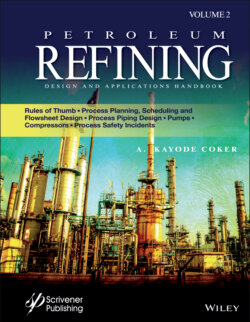Читать книгу Petroleum Refining Design and Applications Handbook - A. Kayode Coker - Страница 3
List of Tables
Оглавление1 Chapter 14Table 14.1 Typical thickness chart—insulation for services 70°F through 1200°F p...Table 14.2 Three programs offer a different mix of features.Table 14.3 Uses of intelligent P&IDs by operations.Table 14.4 A system of equipment designations.Table 14.5 Typical identification for flowsheet process functions.Table 14.6 Instrumentation nomenclature--complete general identification.
2 Chapter 15Table 15.1 Changes in pressure head between upstream and downstream points (sour...Table 15.2 Comparison of dimensions and flow area for tubing and iron pipe size ...Table 15.3 Reynolds number.Table 15.4 Equivalent roughness of various surfaces.Table 15.5 Explicit equations for calculating the friction factor for rough pipe...Table 15.6 Viscosities of petroleum products.Table 15.7 Hazen–Williams C factor.Table 15.8a Suggested fluid velocities in pipe and tubing: liquids, gases, and v...Table 15.8b Typical design* velocities for process system applications.Table 15.9 Equivalent length-to-diameter ratios for fittings.Table 15.10 “K” factor table: representative resistance coefficients (K) for val...Table 15.11 Comparison between the loss coefficient (velocity heads), Kf for pip...Table 15.11a 2-K constants for loss coefficients for valves and fittings.Table 15.11b 3-K constants for loss coefficients for valves and fittings.*Table 15.12 Excess head loss K correlation for changes in pipe size.Table 15.13 Recommended fluid velocity and maximum ΔP for carbon steel vapor lin...Table 15.14 Approximate k values for some common gases (68°F, 14.7psia).Table 15.15 Conditions at the pipe exit as a function of the Mach number.Table 15.16 Limiting critical values.Table 15.17 Simplified flow formula for compressible fluid pressure drop, rate o...Table 15.18 Suggested steam pipe velocities in pipe connecting to steam turbines...Table 15.19a Flow of air through Sch. 40 pipe (used for estimating for detailed ...Table 15.19b Discharge of air through an orifice* in cubic feet of free air per ...Table 15.20 Factor “F” for Babcock steam formula*.Table 15.21 Input data and computer results for maximum compressible fluid in a ...Table 15.22 Dry-gas flow transmission factors.Table 15.23 Pressure-base multipliers for quantity.Table 15.24 Temperature-base multipliers for quantity.Table 15.25 Specific gravity multipliers for quantity.Table 15.26 Flowing-temperature multipliers for quantity.Table 15.27 Characteristics linear velocities of two-phase flow regimes.Table 15.28 Two-phase flow moduli as a function of Martinelli Moduli X.Table 15.29 Martinelli symbols used for two-phase modulus.Table 15.30 Two-phase flow example.Table 15.31 Computer results of two-phase flow pressure drop calculations of Exa...Table 15.32 Computer results of two-phase pressure drop calculation of Example 1...Table 15.33 A glossary of two-phase flow.Table 15.34 Gas–liquid two-phase downflow.Table 15.35 Criteria for sizing connecting lines in vacuum service.Table 15.36 Computer results of line sizes for flashing steam condensate of Exam...Table 15.37 Cameron hydraulic data.*Table 15.38 Results of the simulation of the case study.Table 15.39 In calculating the design pressure for steel piping, the longitudina...
3 Chapter 16Table 16.1 General types or classification of pumps.Table 16.2 Approximate capacity-head ranges for centrifugal pumps.Table 16.3 Effects of fluid density on head.Table 16.4 Basic parts of a centrifugal pump.Table 16.5 Requirements for mechanical seal installations.Table 16.6 Pump selection guide.Table 16.7 Type selection based on liquid handled.Table 16.8 Revised performance calculations of centrifugal pump for handling oil...Table 16.9 Pump materials of construction.Table 16.10 Troubleshooting centrifugal pumps.Table 16.11 Pump installation check list [31].
4 Chapter 17Table 17.1 General compression and vacuum limits.Table 17.2 Comparison of performance for propane.Table 17.3 Compressibility factors, Z.Table 17.4 Approximate ratio of specific heats (“k” values) for various gases.Table 17.5 Constants for molal heat capacity.Table 17.5A Molal heat capacity MCp (ideal-gas state), kJ/mole °C.Table 17.6 Typical reciprocating air compressor data.Table 17.7 Index or rating leakages for single-sealing elements.Table 17.8A General material specifications for noncorrosive applications.Table 17.8B Cast casing materials for low-temperature applications.Table 17.8C Welded casing material for low-temperature applications.Table 17.8D Impeller material for low-temperature applications.Table 17.8E Materials for usual construction of components for process type gas ...Table 17.8F Typical materials of construction for selected centrifugal applicati...Table 17.9A Summary of typical multistage compressor data.Table 17.9B Summary of typical multistage centrifugal compressor data.Table 17.9C Centrifugal Compressor flow range.Table 17.10 Properties of the gas mixture.Table 17.11 Input data and computer results of Example 17.10.Table 17.12 Polytropic efficiencies for various types of machines.Table 17.13 Approximate mechanical losses as a percentage of a gas power require...Table 17.14 The feed components and the mole fractions.Table 17.15 Properties of the gas mixture.Table 17.16 Input data and computer results of Example 17.14.Table 17.17 Application in the natural gas compression, petroleum, and petrochem...Table 17.17A General sizes of various compressors used in the industrial gas ind...Table 17.18 Typical diaphragm compressor process construction materials.Table 17.19 Troubleshooting checklist for reciprocating compressors.Table 17.20 Troubleshooting checklist for centrifugal compressors.
5 Glossary of Petroleum and Technical TerminologyTable 1 Octane numbers of pure hydrocarbons*Table 2 RVP blending values.
